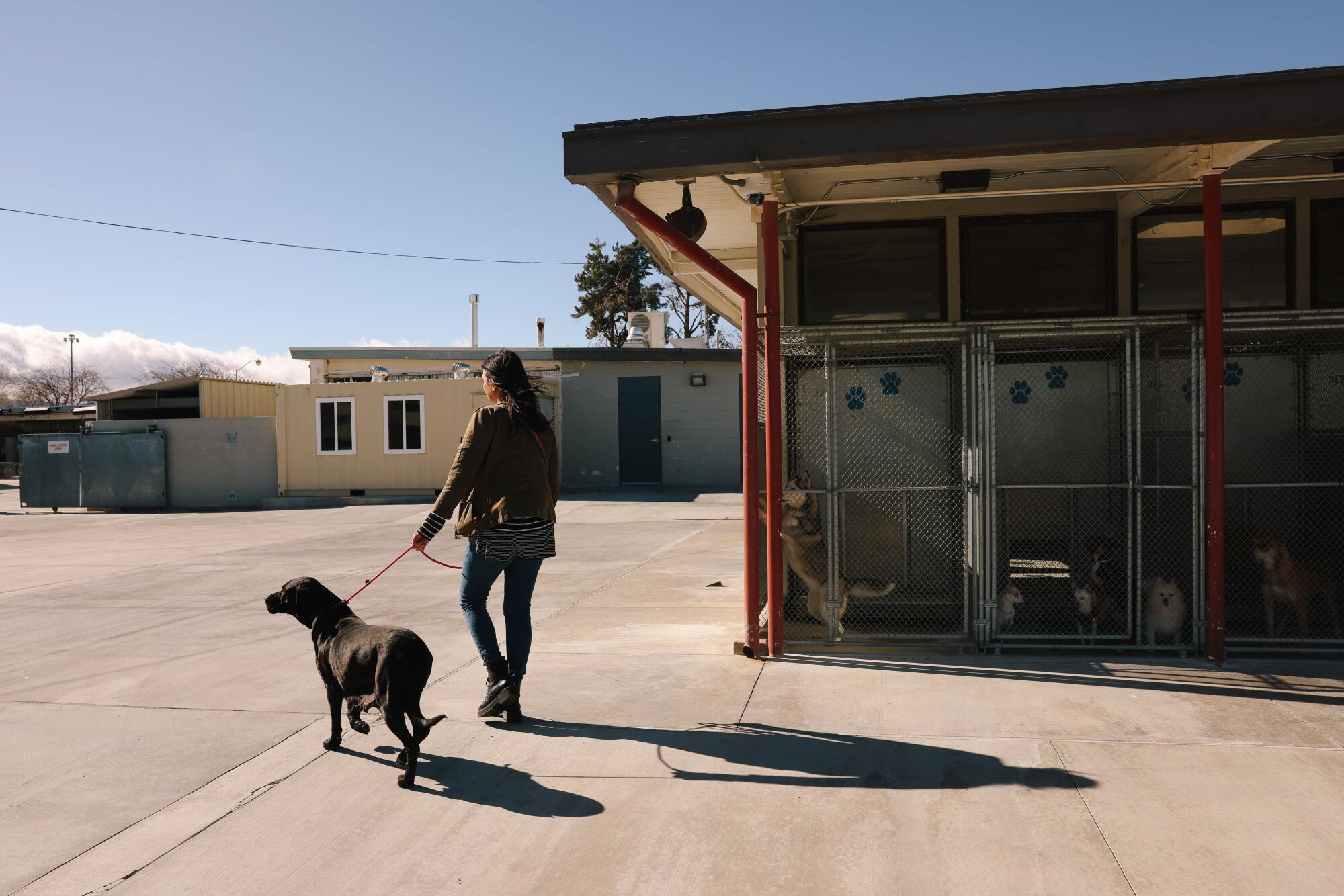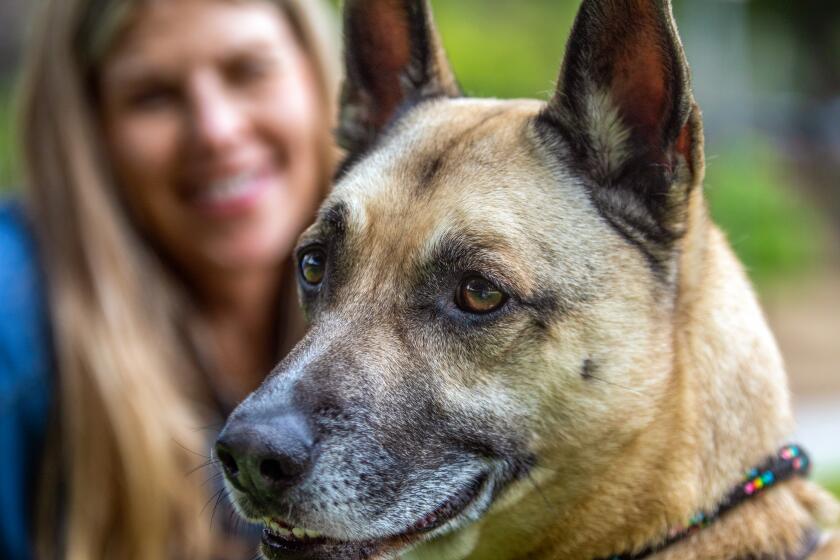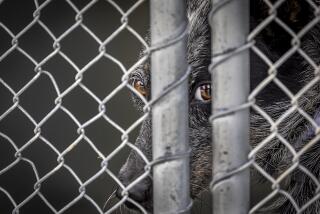
“Grandfather! Look over here!” calls Rita Earl Blackwell, her New York accent dissolving into the whipping wind. Wearing an electric blue jacket emblazoned with the words “Tell Your Dog I Said Hi,” she crouches low to film a dawdling old pug named Jojo with her iPhone.
On this blustery morning, Jojo wears a hooded jacket topped with a redundant pair of ears that flop, to comedic effect, over his own. He sniffs and pees like a guy without a care in the world. Jojo has no idea how narrowly he just escaped euthanasia, thanks to Blackwell and the engaged community she’s built on Instagram.
Blackwell has mastered the art of the shelter dog post as a volunteer predominantly at Lancaster Animal Care Center, which looks a bit like a preschool with its colorful murals of flowers and pets. Yet it also has one of the highest euthanasia rates across L.A. County. Her posts get the attention of celebrities like Jennifer Aniston and good Samaritans such as Terri Jackson, who stands by to transport Jojo to Frosted Faces Foundation, a San Diego-area rescue.

“I saw Rita’s post about this little guy and just couldn’t let him die,” says Jackson. She is not an adopter or volunteer, but she saw Blackwell’s Instagram post about Jojo being cleared for euthanasia and was moved to act. She contacted Frosted Faces, which had an opening if Jojo could find a ride. “I’m driving a 300-mile loop today,” she says, squelching tears.
Animal shelters are dealing with an influx of dogs and cats since the pandemic lockdown, and the overcrowded conditions are leading to higher euthanasia rates.
This is exactly the outcome Blackwell hopes for. “I create the post, but it’s the community, sharing, commenting and tagging, which gets the Instagram algorithm moving,” she says. “Now Terri goes home knowing she saved a life!”
But first, Blackwell must capture Jojo’s “freedom walk.”
In dog rescue parlance, a “freedom walk” is when an animal is seen exiting the shelter because it has been adopted by someone, or taken on by a rescue organization that will ensure its safety and care until it finds its forever home. Blackwell is known on Instagram for her signature freedom walks — always triumphant, life-affirming and beautifully shot. “If I get a million views or more, it’s always with freedom walks,” she says.
“Her social media is brilliant,” says Hillary Rosen of A Purposeful Rescue, who routinely works with Blackwell. “Rita is so personable and good with dogs, but also extremely creative. She has a way of making people feel connected.”
Creating that connection is essential to saving these dogs’ lives.

A professional photographer by trade, Blackwell’s current medium is video because she wants to show “that wiggle” or “wonky tail,” and “how happy these dogs are just to have somebody talking to them.”
She films herself interacting with the dogs, her long dark hair obscuring her face as she pours love onto the lucky pup of the moment. Her videos reveal moving expressions of interspecies bonding, with dogs voraciously licking her face, or melting into her lap as she massages them. “I want people to imagine the dog in their home, on their couch,” she says, “so I’m always rolling around on the grass, making out with all of these dogs!”
After a full day at the shelter, Blackwell spends hours at home crafting posts: editing video, adding music and liaising with the shelter staff to gather details. Some dogs never make it onto her feed because, with her many rescue organization relationships, she can matchmake offline. For the dogs that do appear on Instagram, her more than 100,000 followers share them far and wide, to Oregon for instance, where a family saw a post and hopped on a plane just hours later to save a German shepherd named Brenda. (“That was crazy!” Blackwell says.) Another post reached an A-list celebrity, who reposted. “That dog got adopted immediately! Thank you, Jennifer Aniston!” gushes Blackwell.
From impending euthanasia to glorious safety in a matter of hours, sometimes minutes — these are the extreme lows and highs at Lancaster and other local shelters drowning in the current overpopulation crisis. The problem is largely one of simple math: the number of dogs coming in far exceeds the number of dogs going out by adoption and rescue. Lancaster has only 176 dog kennels, but from October to December of 2023, an average of 821 dogs came in each month, making euthanasia for space a regular occurrence, even among highly adoptable, healthy, social dogs.


In the past, the public would adopt these easygoing dogs, so rescues could focus on saving animals with medical or behavioral issues, Blackwell explains. Now, there are just too many dogs and not enough adopters. “Nobody’s coming, even for these great, happy dogs,” she says.
Amelia Air’s volunteer pilots fly unwanted dogs from kill shelters in rural areas to urban rescue centers, where they have better chances of finding forever homes.
Embracing this sadness, Blackwell holds space for the euthanized dogs she’s known by posting “RIP” compilations, despite losing hundreds of Instagram followers each time she does. “People don’t want to know this part, but these dogs are my friends,” she says, her voice catching. “I want to honor them, and report the reality that we need help.”
Still, Blackwell focuses on the positive. She artfully maintains emotional balance on Instagram, where the three current “RIP” compilations are buoyed by 12 joyous “freedom walk” montages. At times exasperation bleeds through in her captions, but she counters with inclusive calls to action. A recent post ends in a polite plea: “I beg you to please consider adopting your next dog from the shelter.”
Blackwell is often asked how she remains positive under such dire circumstances. All of her responses boil down the same: it’s what’s best for the dogs.

There are way more dogs than available space at the Lancaster Animal Care Center.

Rita Earl Blackwell interacts with Missy at the Lancaster Animal Care Center.
This clarity of mission contributes to her reputation as a volunteer superstar. “Rita does not get caught up in the drama and sadness of the shelter system,” says Kelly Smíšek, co-founder of Frosted Faces, who’s known Blackwell for over a decade. Don Belton, an L.A. County animal control spokesperson, calls Blackwell “an inspiration.”
Blackwell insists it’s not all altruistic. “Are you kidding me? I get to hang out with all of these gorgeous dogs.”
Born into a large family in Staten Island, N.Y., Blackwell ascribes her extreme dog love to never having had a childhood pet. “My mom was like, ‘No dogs!’ so I feel like maybe that’s why I’m obsessed,” she says.
Living in Los Angeles years later, she adopted a brown pit bull named Cherry from a rescue and realized she could help by photographing the organization’s dogs. This led to her “basically stalking every rescue in L.A.” to offer the same. Now she works for Paws For Life K9 Rescue and volunteers at the shelter in her downtime. “I don’t really have time for photography work anymore because I want to be at the shelter all the time,” she says.
How to help overcrowded shelters
While her obvious aim is to save lives, Blackwell also recognizes the importance of making life as good as possible for the dogs during their time at the shelter. “Spending 20 minutes with a dog can make their day,” she says. These small moments of kindness and connection matter, perhaps most for the ones that don’t make it out.
“Rita works with dogs she knows will be euthanized, just so they can have some love and affection,” says Erica Fox of Wags & Walks rescue. “She faces this more head-on than anybody I know.”
After her rescue dog, Buddy, bit someone, Michelle Madden tapped bad-dog experts for help. Their advice made the situation worse, so Madden had to find another solution.
Adoption and rescue alone will not end the overpopulation crisis — Blackwell acknowledges this. Policy and public perception about animal stewardship must change. “Can somebody else please work on that?” she asks, half laughing, half not. “If you need me I’ll be here with the dogs, doing the part I know how to do.”
This reminds Blackwell that there are several dogs whose faces she wants to “scroonch” before she leaves the shelter that day.
Walking the kennels with Blackwell feels like arriving at a surprise party with an exceptionally gregarious guest of honor.


“Oh my god, hello!” she trills at rows of dogs who respond with matched enthusiasm.
“Good morning, babies!” she says with a Fozzie Bear voice, feeding chunks of Pup-peroni to two yowling huskies and a wiggly black lab.
At these coffee shops, restaurant patios, markets, galleries and more, canine companions are greeted with excitement — and maybe even some special treats.
To a matted poodle: “Sweet love, what are you?” To a bouncy boxer: “Where have you been all my life?!”
Blackwell pauses, the cacophony of dogs barking “pick me, pick me!” swelling around her. “If we just put our hearts aside, and think about theirs instead,” she says, flicking a piece of Pup-peroni from her thumb, “we can find all of this love.”
More to Read
It's a date
Get our L.A. Goes Out newsletter, with the week's best events, to help you explore and experience our city.
You may occasionally receive promotional content from the Los Angeles Times.












